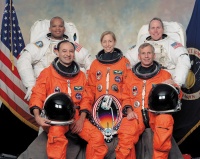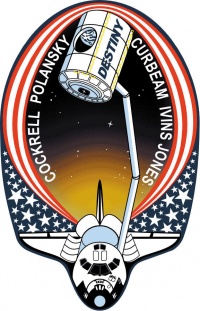STS-98
From The Space Library
 | |
| Organization | NASA-Office of Space Flight (United States) |
|---|---|
| Mission type | Engineering,Human Crew |
| Launch date | February 7, 2001 |
| Launch vehicle | Space Shuttle |
| Launch site | Cape Canaveral, United States |
| COSPAR ID | 2001-006A |
| Inclination | 51.6 degrees |
| Experiments | Here |
| Alternate Names | 26698 |
| Additional Information | Here |
| Data Collection | Here |
| Payload Mass Up | 15098.27 kg |
| Payload Mass Down | 1215 kg |
| Orbiter | Atlantis |
| Lift Off Mass | 2,045,454.55 kg |
| Orbiter Weight at Liftoff | 120,057.73 kg |
| Orbiter Weight at Landing | 90,385.91 kg |
| Landed | Concrete runway 22 at Edwards Air Force Base, Calif. |
| Orbits of Earth | 203 |
| Orbital Altitude | Approximately 200 nautical miles |
Contents |
[edit] Crew
- Commander: Kenneth D. Cockrell
- Pilot: Mark L. Polansky
- Payload Commander:
- Mission Specialist 1: Marsha Ivins
- Mission Specialist 2: Thomas D. Jones
- Mission Specialist 3: Robert L. Curbeam Jr.
- Mission Specialist 4:
- Mission Specialist 5:
- Payload Specialist 1:
- Payload Specialist 2:
ISS/Mir Crew Transport
[edit] Mission
STS 98 is an American shuttle spacecraft that was launched from Cape Canaveral at 23:13 UT. It carried a large module, Destiny and a crew of five astronauts to deliver it to the International Space Station (ISS). It docked with the Unity module on 9 February, and delivered Destiny (2001-006B) to another port on Unity. After many hours of spacewalk, the astronauts secured the electrical connections and mechanical fits. The crew also delivered over a ton of food, fuel and equipment to the ISS. STS 98, with all five astronauts, landed in Edwards AFB in California on 20 February at 20:33 UT due to persistent wind problems at Cape Canaveral.
[edit] EVA
Extravehicular Activity (EVA) conducted by Robert Curbeam and Thomas Jones during three space-walks for a total of 19 hours, 48 minutes. EVA 1, Curbeam and Jones, 7 hours, 34 minutes; Cur-beam and Jones installed and hooked up Destiny to ISS's Unity module. EVA 2, Curbeam and Jones, 6 hours, 50 minutes; Curbeam and Jones attached a station docking adapter to the forward end of Destiny to establish a new docking port for future shuttle assembly flights. EVA 3, Curbeam and Jones, 5 hours, 25 minutes, the 100th spacewalk in U.S. space program history; Curbeam and Jones attached a spare communications antenna on the exterior of the ISS and inspected the exterior of the ISS and the U.S. solar arrays.
[edit] Payload
ISS Assembly Flight 5A; U.S. Laboratory Module "Destiny"
[edit] Books about the Space Shuttle Program
Buy This Book Click here |
Buy This Book here |
Buy This Book Click here |
Buy This Book Click here |





